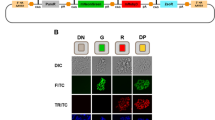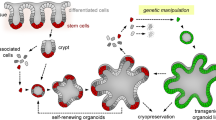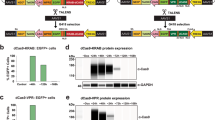Abstract
In multicellular systems cell identity is imprinted by epigenetic regulation circuits, which determine the global transcriptome of adult cells in a cell phenotype–specific manner1,2,3. By combining two repressors, which control each other's expression, we have developed a mammalian epigenetic circuitry able to switch between two stable transgene expression states after transient administration of two alternate drugs. Engineered Chinese hamster ovary cells (CHO-K1) showed toggle switch–specific expression profiles of a human glycoprotein in culture, as well as after microencapsulation and implantation into mice. Switch dynamics and expression stability could be predicted with mathematical models. Epigenetic transgene control through toggle switches is an important tool for engineering artificial gene networks in mammalian cells.
This is a preview of subscription content, access via your institution
Access options
Subscribe to this journal
Receive 12 print issues and online access
$209.00 per year
only $17.42 per issue
Buy this article
- Purchase on Springer Link
- Instant access to full article PDF
Prices may be subject to local taxes which are calculated during checkout




Similar content being viewed by others
References
Rank, G., Prestel, M. & Paro, R. Transcription through intergenic chromosomal memory elements of the Drosophila bithorax complex correlates with an epigenetic switch. Mol. Cell. Biol. 22, 8026–8034 (2002).
Casadesus, J. & D'Ari, R. Memory in bacteria and phage. Bioessays 24, 512–518 (2002).
Kohler, C. & Grossniklaus, U. Epigenetic inheritance of expression states in plant development: the role of Polycomb group proteins. Curr. Opin. Cell Biol. 14, 773–779 (2002).
Malleret, G. et al. Inducible and reversible enhancement of learning, memory, and long-term potentiation by genetic inhibition of calcineurin. Cell 104, 675–686 (2001).
Aubel, D. et al. Design of a novel mammalian screening system for the detection of bioavailable, non-cytotoxic streptogramin antibiotics. J. Antibiot. 54, 44–55 (2001).
Fussenegger, M., Schlatter, S., Datwyler, D., Mazur, X. & Bailey, J.E. Controlled proliferation by multigene metabolic engineering enhances the productivity of Chinese hamster ovary cells. Nat. Biotechnol. 16, 468–472 (1998).
Rivera, V.M. et al. Long-term regulated expression of growth hormone in mice after intramuscular gene transfer. Proc. Natl. Acad. Sci. USA 96, 8657–8662 (1999).
Niwa, H., Miyazaki, J. & Smith, A.G. Quantitative expression of Oct-3/4 defines differentiation, dedifferentiation or self-renewal of ES cells. Nature Genet. 24, 372–376 (2000).
Gossen, M. & Bujard, H. Tight control of gene expression in mammalian cells by tetracycline-responsive promoters. Proc. Natl. Acad. Sci. USA 89, 5547–5551 (1992).
Yao, F. et al. Tetracycline repressor, tetR, rather than the tetR-mammalian cell transcription factor fusion derivatives, regulates inducible gene expression in mammalian cells. Hum. Gene Ther. 9, 1939–1950 (1998).
Fussenegger, M. et al. Streptogramin-based gene regulation systems for mammalian cells. Nat. Biotechnol. 18, 1203–1208 (2000).
Weber, W. et al. Macrolide-based transgene control in mammalian cells and mice. Nat. Biotechnol. 20, 901–907 (2002).
Weber, W. et al. Streptomyces-derived quorum-sensing systems engineered for adjustable transgene expression in mammalian cells and mice. Nucleic Acids Res. 31, e71 (2003).
Moosmann, P., Georgiev, O., Thiesen, H.J., Hagmann, M. & Schaffner, W. Silencing of RNA polymerases II and III-dependent transcription by the KRAB protein domain of KOX1, a Kruppel-type zinc finger factor. Biol. Chem. 378, 669–677 (1997).
Kapunisk-Uner, J.E., Sande, M.A. & Chambers, H.F.S. in Goodman and Gilman's The Pharmacological Basis of Therapeutics (ed. Limbierd, L.E.) 1123–1153 (McGraw-Hill, New York, 1996).
Wegener, H.C., Bager, F. & Aarestrup, F.M. Surveillance of antimicrobial resistance in humans, food stuffs and livestock in Denmark. Euro. Surveill. 2, 17–19 (1997).
Orlando, V. Polycomb, epigenomes, and control of cell identity. Cell 112, 599–606 (2003).
Hasty, J., McMillen, D. & Collins, J.J. Engineered gene circuits. Nature 420, 224–230 (2002).
Elowitz, M.B. & Leibler, S. A synthetic oscillatory network of transcriptional regulators. Nature 403, 335–338 (2000).
Atkinson, M.R., Savageau, M.A., Myers, J.T. & Ninfa, A.J. Development of genetic circuitry exhibiting toggle switch or oscillatory behavior in Escherichia coli. Cell 113, 597–607 (2003).
Gardner, T.S., Cantor, C.R. & Collins, J.J. Construction of a genetic toggle switch in Escherichia coli. Nature 403, 339–342 (2000).
Moser, S. et al. An update of pTRIDENT multicistronic expression vectors: pTRIDENTs containing novel streptogramin-responsive promoters. Biotechnol. Prog. 16, 724–735 (2000).
Weber, W. et al. Versatile macrolide-responsive mammalian expression vectors for multiregulated multigene metabolic engineering. Biotechnol. Bioeng. 80, 691–705 (2002).
Schlatter, S., Rimann, M., Kelm, J. & Fussenegger, M. SAMY, a novel mammalian reporter gene derived from Bacillus stearothermophilus alpha-amylase. Gene 282, 19–31 (2002).
Berger, J., Hauber, J., Hauber, R., Geiger, R. & Cullen, B.R. Secreted placental alkaline phosphatase: a powerful new quantitative indicator of gene expression in eukaryotic cells. Gene 66, 1–10 (1988).
Cherry, J.L. & Adler, F.R. How to make a biological switch. J. Theor. Biol. 203, 117–133 (2000).
Ermentrout, B. Simulating, Analyzing, and Animating Dynamical Systems (Society for Industrial & Applied Mathemetics, Pittsburgh, PA, 2002).
Corish, P. & Tyler-Smith, C. Attenuation of green fluorescent protein half-life in mammalian cells. Protein Eng. 12, 1035–1040 (1999).
Acknowledgements
We thank Martine Gilet for skillful assistance on in vivo experiments, Eva Niederer for FACS-mediated single-cell sorting, Valeria Gonzalez-Nicolini for useful discussions and Cornelia Fux for technical advice. This work was supported by the Swiss National Science Foundation (grant no. 631-065946) as well as the Novartis Foundation.
Author information
Authors and Affiliations
Corresponding author
Ethics declarations
Competing interests
The authors declare no competing financial interests.
Rights and permissions
About this article
Cite this article
Kramer, B., Viretta, A., Baba, ME. et al. An engineered epigenetic transgene switch in mammalian cells. Nat Biotechnol 22, 867–870 (2004). https://doi.org/10.1038/nbt980
Received:
Accepted:
Published:
Issue Date:
DOI: https://doi.org/10.1038/nbt980
This article is cited by
-
Modelling genetic stability in engineered cell populations
Nature Communications (2023)
-
Engineered systems of inducible anti-repressors for the next generation of biological programming
Nature Communications (2020)
-
A gene signal amplifier platform for monitoring the unfolded protein response
Nature Chemical Biology (2020)
-
Transcriptional programming using engineered systems of transcription factors and genetic architectures
Nature Communications (2019)
-
Programmable mutually exclusive alternative splicing for generating RNA and protein diversity
Nature Communications (2019)



